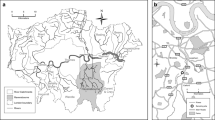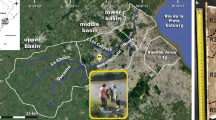Abstract
The bed and suspended (slime) sediment phases associated with effluent water that are produced from phosphate-ore-upgrading process at Al-Abyad mine in the southern part of Jordan were analyzed chemically and mineralogically. The results show that the effluent water is highly oxic and mildly alkaline in nature. The geochemical behavior of each phase was controlled by the effluent water physicochemical parameters, sediment particle size, mineralogical constituents of the studied phases, and the prevailing climatic nature of the area. Bed sediments have higher concentrations of many elements than slime. Accordingly, the bed sediments can be considered as a sink rather than a pool for many elements. The geochemical dissociation of major oxides and trace elements between bed and slime sediments was evident using t test, particularly between P2O5, SiO2, CaO, K2O, Mn, Sr, Y, and Co, and to lesser extent, V, U, Zn, and Cr. This might be attributed to effluent water characteristics, mineralogy, and the presence of fine-grained materials. The spatial distribution of major oxide and trace element concentrations along the stream drainage exhibited a slight increase with distance either in bed or slime sediment phases. However, they increased suddenly at the last three sampling sites, which might be due to the abundance of fine-grained materials that are mainly composed of clay minerals (montmorillonite) that would enhance the adsorption process. Moreover, the XRD results confirmed the existence of elemental geochemical dissociation as a function of mineral control.





Similar content being viewed by others
References
Abed, A. (1982) Geology of Jordan. Al-Nahda Al-Islameiah Library, Amman (in Arabic) p 232
Algeo JA, Maynard JB (2004) Trace element behavior and redox facies in core shales of upper Pennsylvanian Kansas-type cyclothem. Chem Geol (in press)
Al-Hwaiti M, Gaunter M, Saffarini Gh (2001) Geostatistical and geochemical investigation on Shidiya phosphorites western orebody, south Jordan: variation in ore composition and its content of toxic heavy metals available for plant absorption. In: Paper presented at the 7th Jordan geological conference, University of Jordan, Amman, 7–9 April 2001
Bakac M (2000) Factor analysis applied to a geochemical study of suspended sediments from the Gediz River, Western Turkey. Environ Geochem Health 22:93–111
Barbanti A, Bothner MH (1993) A procedure for partitioning bulk sediments into distinct grain-size fractions for geochemical analysis. Environ Geol 21:3–31
Beerbaum B (1977) Diagene der marin—sedimentaren phosphate lay erstalle von Al-Hasa, Jordan, Germany
Bender F (1974) Explanatory notes on the geological map of wadi Araba, Jordan. 1:100,000, 3 sheets. Geol Jahrb 10:3–62
Brookins DG (1988) E h–pH diagrams for geochemistry. Springer, Berlin Heidelberg New York, p 176
Dekov VM, Komy Z, Araujo F, Van Put A, Van Grieken R (1997) Chemical composition of sediments, suspended matter, river water and groundwater of the Nile (Aswan-Sohag traverse). Sci Total Environ 20:195–210
El-Hiyari MA (1985) The geology of Jabal Al-Mutarammil, sheet map 3252 III. Unpublished Report, NRA, Amman, 50
Facetti J, Dekov VM, Van Grieken R (1998) Heavy metals in sediments from the Paraguay River: a preliminary study. Sci Total Environ 209:79–86
Ghosheh A, Dodeen F (1993) Heavy metals in Jordan phosphate rock. In: Proceedings of the 4th international fertilizer seminar, Amman p 36
Howard AG (1998) Aquatic environmental chemistry. Oxford Press, London, p 90
Jiries A, El-Hasan T, Al-Hiwati M, Seiler KP (2004) Evaluation of the effluent water quality produced from phosphate mines in Central Jordan. Mine Water Environ 23(3):133–137
Jordanian Phosphate Mines Company (JPMC) (1998) Annual Report for surveying and studying of water resources in the phosphate mines. Al-Shamil Engineering, Amman, p 167
Khaled H, Abed A (1980) Uranium in Esh-Shidyia phosphates. Dirasat 8(2):57–66
Khaled H, Schneider W, Zachmann D (1990) Sedimentological and geochemical pattern of Jordanian phosphate deposits. In: Paper presented at the 3rd Jordan geological conference, University of Jordan, Amman, 11–13 April 1990
Korfali SI, Davies BE (2003) A comparison of metals in sediments and water in the River Nahr-Ibrahim, Lebanon: 1996 and 1999. Environ Geochem Health 25:41–50
Lee S, Moon JW, Moon HS (2003) Heavy metals in the bed and suspended sediments of Anyang River, Korea: implications for water quality. Environ Geochem Health 25:433–452
Martin JM, Meyback M (1979) Elemental mass-balance of material carried by major world rivers. Mar Chem 7:173–206
Peech AJ (1947) Methods of soil analysis for soil-fertility investigation. U.S. Department of Agriculture Circular 757
Sadaqa R, Abed A, Grimm K, Pufahl P (2001) Oxygen and carbon isotopes in the Jordanian phosphorites and associated fossils. In: Proceedings of the 7th Jord. geological conference (Book of abstracts), 81 pp
Soares HM, Boaventura RAR, Machado AAS, Esteves da Silva JCG (1999) Sediments as monitors of heavy metal contamination in the Ave river basin (Portugal): multivariate analysis of data. Environ Pollut 105:311–323
Song Y, Wilson MJ, Moon HS, Bacon JR, Bain DC (1999) Chemical and mineralogical forms of lead, zinc and cadmium in particle size fractions of some wastes, sediments and soils in Korea. Appl Geochem 14:621–633
Zelmach J (1999) Uranium remediation from the mines water using natural processes, Personal Communication
Zoumis T, Schmidt A, Grigorova L, Calmano W (2001) Contaminant in sediments: remobilization and demobilization. Sci Total Environ 266:195–202
Acknowledgments
The author thanks Abdel Hamed Shoman Foundation for their generous financial support of this project and the Jordanian Phosphate Mines Company administrations for their field support. The author also thanks Prof. Dr. Anwar Jiries and Dr. Onf Ziadat for reviewing the language of the article and to Dr. Abdelsalam Edili for his invaluable statistical revision.
Author information
Authors and Affiliations
Corresponding author
Rights and permissions
About this article
Cite this article
El-Hasan, T. Geochemical dissociation of major and trace elements in bed and suspended sediment phases of the phosphate mines effluent water, Jordan. Environ Geol 51, 621–629 (2006). https://doi.org/10.1007/s00254-006-0357-3
Received:
Accepted:
Published:
Issue Date:
DOI: https://doi.org/10.1007/s00254-006-0357-3




